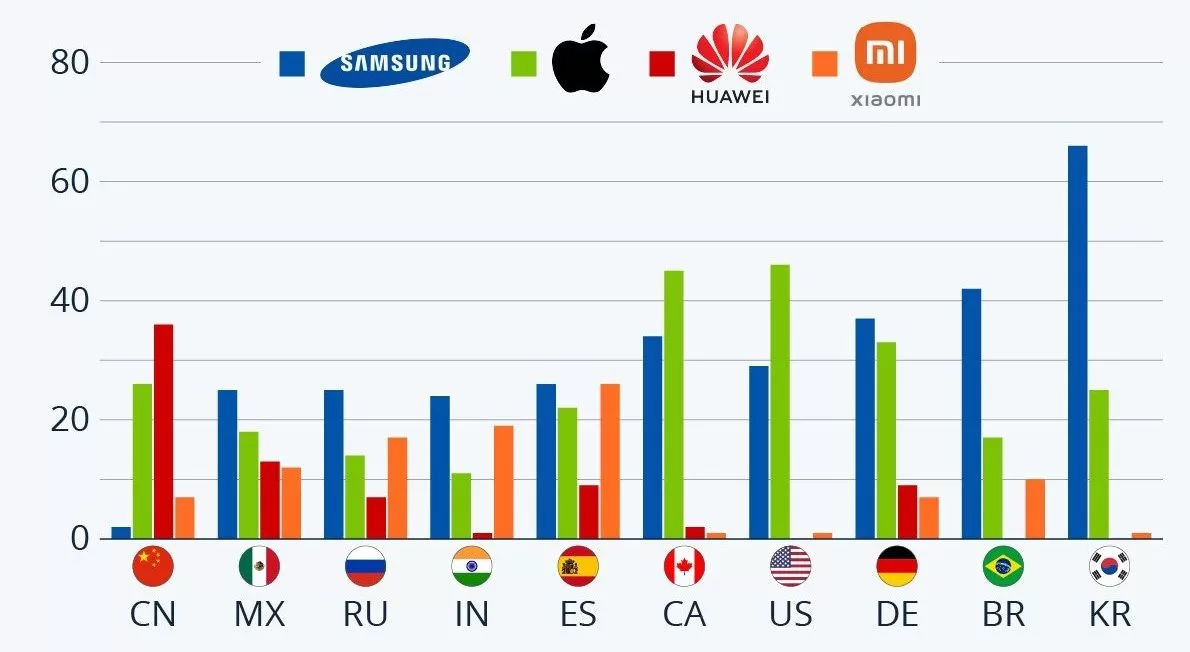Smartphone Giants Maintain Local Dominance: A Global Market Snapshot

Key Insights
- Samsung, Apple, Huawei, and Xiaomi collectively hold over 50% of the global smartphone market.
- Each of these brands maintains a distinct advantage in their respective home countries.
- Samsung dominates the South Korean market with a staggering 66% market share.
- Apple commands the majority share in the U.S. and Canada, alongside a substantial Samsung customer base.
- Germany and Brazil show strong affinity towards Samsung, with ownership rates ranging from 37% to 42%.
- Spain, Russia, and Mexico present diverse markets, where no single brand exceeds a 25% market share.
- In India, the smartphone market is highly fragmented with Vivo, OPPO, OnePlus, and Realme collectively capturing between 7% and 10% of the market.
- Understanding regional preferences is crucial for smartphone manufacturers aiming for sustained global success.
Global Smartphone Market Dynamics
In the dynamic landscape of smartphone manufacturers, giants like Samsung, Apple, Huawei, and Xiaomi collectively command over 50 percent of the global market. These tech behemoths have not only permeated international markets but have also managed to retain distinctive advantages on their home turfs. Apple reigns supreme in the U.S. and Canada, Samsung boasts a staggering market share in South Korea, and Huawei and Xiaomi together claim a substantial 43 percent share in China.
According to a recent survey conducted by Statista’s Consumer Insights, a resounding 66 percent of South Korean respondents declared Samsung as their primary smartphone brand – the highest recorded figure in the study. The dominance of Samsung is not confined to its home country, as it also enjoys robust support in Germany and Brazil. In these nations, between 37 and 42 percent of smartphone owners have Samsung devices as their main go-to.
Despite Apple’s stronghold in the U.S. and Canada, Samsung has carved out a formidable customer base in these regions as well, capturing between 29 and 34 percent of the smartphone market share. This dual dominance paints a vivid picture of the fierce competition between these two industry titans.
Spain, Russia, and Mexico present a more nuanced scenario, with none of the four major brands managing to secure more than a quarter of the market. While these tech giants enjoy a reach of over 80 percent in Spain, their influence in India is notably lower, connecting with only 55 percent of Indian consumers. Here, a diverse array of smartphone brands beyond the big four contribute to a vibrant and fragmented market. Vivo, OPPO, OnePlus, and Realme each claim a share of between 7 and 10 percent among Indian respondents.
The global smartphone landscape is a dynamic arena, shaped by consumer preferences, technological innovations, and regional loyalties. As giants like Samsung, Apple, Huawei, and Xiaomi continue to jostle for supremacy, their ability to adapt to local markets may well be the key to enduring success in an ever-evolving industry.















